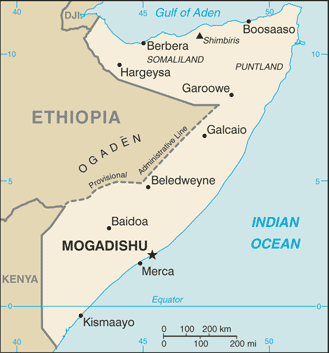Somalia Background Information
 Britain withdrew from British Somaliland in 1960 to allow its protectorate to join with Italian Somaliland and form the new nation of Somalia. In 1969, a coup headed by Mohamed SIAD Barre ushered in an authoritarian socialist rule that managed to impose a degree of stability in the country for a couple of decades. After the regime's overthrow early in 1991, Somalia descended into turmoil, factional fighting, and anarchy. In May 1991, northern clans declared an independent Republic of Somaliland that now includes the administrative regions of Awdal, Woqooyi Galbeed, Togdheer, Sanaag, and Sool. Although not recognized by any government, this entity has maintained a stable existence, aided by the overwhelming dominance of a ruling clan and economic infrastructure left behind by British, Russian, and American military assistance programs. The regions of Bari, Nugaal, and northern Mudug comprise a neighboring self-declared autonomous state of Puntland, which has been self-governing since 1998 but does not aim at independence; it has also made strides toward reconstructing a legitimate, representative government but has suffered some civil strife. Puntland disputes its border with Somaliland as it also claims portions of eastern Sool and Sanaag. Beginning in 1993, a two-year UN humanitarian effort (primarily in the south) was able to alleviate famine conditions, but when the UN withdrew in 1995, having suffered significant casualties, order still had not been restored. The mandate of the Transitional National Government (TNG), created in August 2000 in Arta, Djibouti, expired in August 2003. A two-year peace process, led by the Government of Kenya under the auspices of the Intergovernmental Authority on Development (IGAD), concluded in October 2004 with the election of Abdullahi YUSUF Ahmed as President of the Transitional Federal Government of Somalia and the formation of a transitional government, known as the Somalia Transitional Federal Institutions (TFIs). The Somalia TFIs include a 275-member parliamentary body, known as the Transitional Federal Assembly (TFA), a transitional Prime Minister, Ali Mohamed GEDI, and a 90-member cabinet. The Transitional Federal Government (TFG) has been deeply divided since just after its creation and until late December 2006 controlled only the town of Baidoa. In June 2006, a loose coalition of clerics, business leaders, and Islamic court militias known as the Supreme Council of Islamic Courts (SCIC) defeated powerful Mogadishu warlords and took control of the capital. The Courts continued to expand, spreading their influence throughout much of southern Somalia and threatening to overthrow the TFG in Baidoa. Ethiopian and TFG forces, concerned over suspected links between some SCIC factions and al-Qaida, in late December 2006 drove the SCIC from power, but the joint forces continue to fight remnants of SCIC militia in the southwestern corner of Somalia near the Kenyan border. The TFG, backed by Ethiopian forces, in late December 2006 moved into Mogadishu, but it continues to struggle to exert control over the capital and to prevent the reemergence of warlord rule that typified Mogadishu before the rise of the SCIC.
Britain withdrew from British Somaliland in 1960 to allow its protectorate to join with Italian Somaliland and form the new nation of Somalia. In 1969, a coup headed by Mohamed SIAD Barre ushered in an authoritarian socialist rule that managed to impose a degree of stability in the country for a couple of decades. After the regime's overthrow early in 1991, Somalia descended into turmoil, factional fighting, and anarchy. In May 1991, northern clans declared an independent Republic of Somaliland that now includes the administrative regions of Awdal, Woqooyi Galbeed, Togdheer, Sanaag, and Sool. Although not recognized by any government, this entity has maintained a stable existence, aided by the overwhelming dominance of a ruling clan and economic infrastructure left behind by British, Russian, and American military assistance programs. The regions of Bari, Nugaal, and northern Mudug comprise a neighboring self-declared autonomous state of Puntland, which has been self-governing since 1998 but does not aim at independence; it has also made strides toward reconstructing a legitimate, representative government but has suffered some civil strife. Puntland disputes its border with Somaliland as it also claims portions of eastern Sool and Sanaag. Beginning in 1993, a two-year UN humanitarian effort (primarily in the south) was able to alleviate famine conditions, but when the UN withdrew in 1995, having suffered significant casualties, order still had not been restored. The mandate of the Transitional National Government (TNG), created in August 2000 in Arta, Djibouti, expired in August 2003. A two-year peace process, led by the Government of Kenya under the auspices of the Intergovernmental Authority on Development (IGAD), concluded in October 2004 with the election of Abdullahi YUSUF Ahmed as President of the Transitional Federal Government of Somalia and the formation of a transitional government, known as the Somalia Transitional Federal Institutions (TFIs). The Somalia TFIs include a 275-member parliamentary body, known as the Transitional Federal Assembly (TFA), a transitional Prime Minister, Ali Mohamed GEDI, and a 90-member cabinet. The Transitional Federal Government (TFG) has been deeply divided since just after its creation and until late December 2006 controlled only the town of Baidoa. In June 2006, a loose coalition of clerics, business leaders, and Islamic court militias known as the Supreme Council of Islamic Courts (SCIC) defeated powerful Mogadishu warlords and took control of the capital. The Courts continued to expand, spreading their influence throughout much of southern Somalia and threatening to overthrow the TFG in Baidoa. Ethiopian and TFG forces, concerned over suspected links between some SCIC factions and al-Qaida, in late December 2006 drove the SCIC from power, but the joint forces continue to fight remnants of SCIC militia in the southwestern corner of Somalia near the Kenyan border. The TFG, backed by Ethiopian forces, in late December 2006 moved into Mogadishu, but it continues to struggle to exert control over the capital and to prevent the reemergence of warlord rule that typified Mogadishu before the rise of the SCIC.